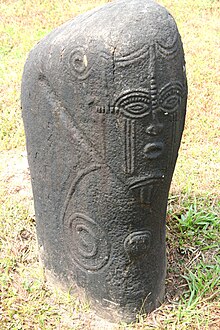Monoliths from Alok Ikom

The monoliths of Alok Ikom (also: Ikom monoliths, Ekoi : Akwasnshi / Atal) are a series of monoliths made of volcanic rock in the district of Ikom in the state of Cross River in Nigeria .
description
The approximately 300 monoliths are between 30 and 180 centimeters high and were set up in a good 30 circular formations in the area of Ikom . The phallic monoliths are covered with stylized faces, patterns and inscriptions. Researchers and linguists consider the previously indecipherable inscriptions to be writing and a form of visual communication.
They were formed from naturally occurring basalt and are spread over an area of 650 square kilometers that are inhabited by six groups of the Ekoi . They were probably made between the 16th and 19th centuries, but cannot currently be dated more precisely. The monoliths stand in (often perfect) circles and face each other. They found themselves on the outskirts of (nowadays often abandoned) villages, sometimes also at the central meeting place of the village elders. Although there are always recurring elements (two eyes, open mouth, forehead crowned with rings, stylized goatee, distinctive navel), each monolith is unique.
conservation
The extreme weather conditions in the region lead to the erosion of the monoliths; Their location in a region with little touristic development makes maintenance difficult. In 2008 the World Monuments Fund put it on its list of endangered sites. You are on the tentative list of the UNESCO World Heritage Committee.
In museums
The British Museum has a medium-sized Ikom monolith with human features.
Individual evidence
- ↑ UNESCO World Heritage Center: Alok Ikom Stone Monoliths - UNESCO World Heritage Center .
- ^ Ikom Monoliths of Cross River State | World Monuments Fund .
- ^ Ikom Monolith at the British Museum .
- ↑ Alok Ikom Stone Monoliths .
- ^ Ikom Monoliths of Cross River State . Retrieved February 20, 2019.
- ↑ figure .